SCUBA Diving at Hedonism II
What to expect underwater
The diving at Hedo is stunning and at times breath-taking.
If the diving in the Grand Caymans is a 10, then Hedo is a 6 going on
7. The reefs have recovered
nicely from the 1970s dynamiting-style of fishing and the hurricanes of the
last decade.
Underwater, you will see numerous coral outcroppings that form massive heads, as well as walls and ledges, some which are up to 100 foot in depth. You can see barrel coral big enough to swallow a diver. And there are a variety of sponges in vivid colors, as well as vibrant fans-some quite large.
Underwater wild life includes turtles, spade fish, drummers, king fish,
nurse sharks (I have seen sharks on about 10 percent of my dives), several
varieties of parrot fish in great abundance (some schools number in the
hundreds), snappers, mackerels, bar jack fish, sergeant majors, octopus
(more of a night creature, though), gray rays, spotted eagle rays, electric
rays, green and spotted moray eels, craps, lobsters, blenny fish, barracuda,
rock fish, several varieties of trigger fish, damsel fish, Garibaldi fish,
trunk fish (called Boc fish locally), Angel fish, banded butterfly fish,
yellowheaded Wrasse fish, squirrel fish, sand diver fish (called dragon fish
locally), occasionally sightings of Searobin fish (bottom fins act as legs),
trumpet fish, needle fish, groupers, seaperch, tuna, sharksucker (locally
called Ramona), peacock flounder and flying fish just to name a few species
that I have seen.
One of the more incredible experiences was diving with several dolphin pods.
They are wild, but still very curious of who I was.
A curious youngster came within 10 feet of me before an adult came over
and bumped it away. Does not
happen every trip, but when it does it becomes an unforgettable experience.
Water temperature varies by the season, as expected.
During the winter months, the water temperature is usually 84F(29C),
even at 90 feet (30m). During the
summer months, the water temperature increases to 88F(31).
I find a 0.5mm or even a 2mm suit recommended for the winter months.
I use just a full-body Lycra suit during the summer.
Water visibility often exceeds 100 feet (30m), but a passing storm can
reduce that to 60 feet (20m) of even less.
Still, that is not that bad; remember the 5 feet visibility in the quarry or
kelp forest during your certification dives?
The dive procedures at Hedo
If
you are a certified SCUBA diver, do not forget to take your certification
card. Far too often, I have
seen the certified divers arrive without their card.
The staff attempts to send a fax to get your number, but this can take
several Jamaican days. You will
be asked to fill out the waiver form and medical checklist.
Many times, you will find Derrick Ritchie, pictured here, at the
check-in desk to help you register.
If it has been a while since your last dive, the divemasters will organize a
refresher dive for either the pool and/or the resort certified (see below)
dive. The checkout dive is
free.
Once registered, the divemaster will ask you to go on the 'shallow' dive
first.
This dive leaves at 11:30am and is a 60 foot (20m) dive for 40 minutes.
Most likely, you will be diving the next day, as the current day’s
dives are likely to be filled.
But if you are early enough and there is space, you could be diving the same
day.
Once the ‘observation dive’ is completed, you can choose to the deep or
shallow dive for your subsequent days.
The deep dive leaves at 9:30am and is a 90-foot (30m) dive for 20 minutes.
My experience is that the fish are larger on the deep dive, but not as
plentiful as the 60-foot (20m) dive.
You must sign up the day before the dive.
Since you are carrying a depth gauge, the divemasters will be checking your
tank pressure about two-thirds of the way thru the dive and then at 5 minute
intervals after that. The ‘low
air’ pressure indicator for the 90-foot dive is 700psi; for the 60-foot
dive, it is 500psi. If you do
hit the ‘low air’ pressure mark you should notify your buddy and divemasters,
then start a slow accent. At
Hedo, your dive buddy need not go with you, but they may if they want.
For safety issues, you should not try to hide your pressure gauge if
you go under the ‘low pressure’ mark.
If more than one diver does this, the divemaster will potentially have
his hands too full.
Both the deep dive and shallow dive end with a 3 minute safely stop at 15 to
20 feet. Good time to practice
shallow water buoyancy, and mentally review what you saw during the dive.
There is no safety stop for the 30-foot (10m) resort certified dive, as
the nitrogen loading is not very significant.
All dives at Hedo are drift dives, so you need not swim against the current
to return to the boat. The boat
will come to get you. True
pleasure.
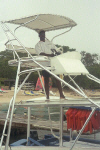 Once
on the surface, the diveboat, captained normally by Monk, will
motor over to pick you up. You
get back on the boat using a ladder off the stern.
If you cannot get back up the ladder with your equipment on, take it
off and Monk will assist you getting everything safely on board.
Once
on the surface, the diveboat, captained normally by Monk, will
motor over to pick you up. You
get back on the boat using a ladder off the stern.
If you cannot get back up the ladder with your equipment on, take it
off and Monk will assist you getting everything safely on board.
Different dive sites are selected each day.
The dive site is picked as the boat leaves the dock. My favorite deep dive sites include the two locations off
Green Island (especially green Island Wall), Joe’s Reef (Bloody Bay #1 with
the deep plane), Upper Bloody Bay (Bloody Bay #2), and a new site—as yet
unnamed officially – that I call Bloody Bay #3.
The amount of different wild life on the BB3 dive is usually
incredible. Also on my deep
dive list would be Turtle Drop, King Fish Point and Sand’s club (sunken
tugboat) and a bit further along the coast is Orange Bay.
My favorite shallow dive sights includes the Arches (shallow plane),
Ritchie’s Gallery, the Galleria, Throne Room and the shallow site in the
Green Island bay.
If you have your own dive equipment and do not want to bring it all, I would
at least recommend bringing your mask, and potentially your fins & booties.
That way you will know this equipment will fit correctly.
The fins at Hedo are 'warm water’ fins with a full foot design.
I prefer the 'cold water' fin that is worn with a booty.
That way, if you lose a fin (or when you take the fins off to get up
the ladder at the end of the dive), your foot is still protected
Night diving is available at Hedo, but at additional costs. Budget about $40 for the evening. The divemasters will provide the night-lights.
The usual site for the night dive is the Arches; that may include some
very interesting collections of night creatures, such as 3-foot wide basket
star fish, as well as octopus, higher density of puffers and more crabs.
Is it really included, like really free; Really?
 Absolutely,
everything is free: the dive, the divemaster, the equipment, the ride to the
site, the storage of your own equipment.
Many resorts charge for use of weights, but not at Hedo.
Everything is free.
Absolutely,
everything is free: the dive, the divemaster, the equipment, the ride to the
site, the storage of your own equipment.
Many resorts charge for use of weights, but not at Hedo.
Everything is free. 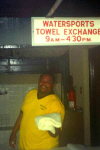 The mask and fin equipment
for snorkeling and scuba is handed out normally by Noel, who also dispenses
the majority of the towels.
I call him the gatekeeper; he knows where everyone is and monitors the
beach very diligently.
The mask and fin equipment
for snorkeling and scuba is handed out normally by Noel, who also dispenses
the majority of the towels.
I call him the gatekeeper; he knows where everyone is and monitors the
beach very diligently.
Hedo II Scuba Facilities
 Hedo
uses aluminum-based 80 cubic foot tanks, equipped with k-type value (no low
air release valve). You have to
be really old (like me) to remember the original J-type value.
Hedo
uses aluminum-based 80 cubic foot tanks, equipped with k-type value (no low
air release valve). You have to
be really old (like me) to remember the original J-type value.
 All
the regulators are equipped with a depth gauge, a tank pressure gauge and
two second-stage regulators and an inflator hose to attach to the BCD.
This setup is pretty much the standard for warm water diving.
All
the regulators are equipped with a depth gauge, a tank pressure gauge and
two second-stage regulators and an inflator hose to attach to the BCD.
This setup is pretty much the standard for warm water diving.
The Buoyancy Compensating Devices (BCDs) are of the non-integrated weights
design.
They came in small, medium and large sizes.
My experience is that they are generously cut.
A large BCD can easily adapt to a 275+ pound person.
Each has a whistle attached.
Weights are lead blocks, slotted to side onto a weight belt. If you bring your own BCD with integrated weight pockets,
just ask for some free weights.
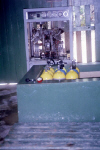 The
tanks are filled daily, and the compressor intake is located well above the
roofline of the dive shack to prevent pollutants from being pumped into the
compressor.
The
tanks are filled daily, and the compressor intake is located well above the
roofline of the dive shack to prevent pollutants from being pumped into the
compressor.
 The
divemasters take all the equipment down to the dive boat, except for your
fins and mask, in a trolley.
More importantly, they will take the equipment back to the dive shack, which
is an uphill trip.
The
divemasters take all the equipment down to the dive boat, except for your
fins and mask, in a trolley.
More importantly, they will take the equipment back to the dive shack, which
is an uphill trip.
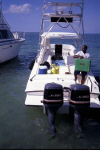 Safety
is always uppermost for the dive staff at Hedo. The diveboat has a radio for and carries the DAN-sponsored
emergency kit.
Safety
is always uppermost for the dive staff at Hedo. The diveboat has a radio for and carries the DAN-sponsored
emergency kit.
The nearest decompression tank is located in Montego Bay, a 3 hours car ride
away.
Helicopter transport can be arranged in extreme emergencies.
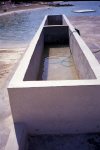 On
the dock, near where the diveboat returns, is an equipment rinsing tank,
filled about every 2 to 3 days with fresh water.
On
the dock, near where the diveboat returns, is an equipment rinsing tank,
filled about every 2 to 3 days with fresh water.
 If
you wish to store your equipment in the dive shack overnight, bins are
available within the dive shack for your dive bag. The room is secured nightly.
If
you wish to store your equipment in the dive shack overnight, bins are
available within the dive shack for your dive bag. The room is secured nightly.
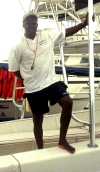 The
diveboat is a modified cigarette-style speedboat with a flying bridge.
Tanks sit in restraints toward the bow.
Twin 250hp outboard engines power the diveboat.
The ride to the dive sites is usually a ‘kick-ass’ experience.
The longest boat ride is about 20 to 25 minutes; most are less than 10
to 15 minutes. The boat driver
is an expert captain named Monk.
The
diveboat is a modified cigarette-style speedboat with a flying bridge.
Tanks sit in restraints toward the bow.
Twin 250hp outboard engines power the diveboat.
The ride to the dive sites is usually a ‘kick-ass’ experience.
The longest boat ride is about 20 to 25 minutes; most are less than 10
to 15 minutes. The boat driver
is an expert captain named Monk.
He knows where the dive sites are by land reference positioning, and will be
right above you as you come up from the safety stop at the end of the dive.
Additional
divemasters include Anthony Reeves. His current assignment is the lead diver on the 90-foot (30m) dive.
He is very hard working, and takes his assignment very seriously.
Another of the dive staff is Myron, a young diver replacing Aston, of whom I
did not get a picture. He has a
tremendous sense of humor, and is a passionate cricket player. His assignment is normally the back-of-the-pack diver for the
60-foot (20m) dive. I call him
the enforcer (he would smile).
He is diligent in keeping the group together and monitoring the depth
gauges.
Getting certified: resort and PADI training
Hedo offers a "resort certification" for non-certified divers free of charge
for both the training and, of course, all the scuba equipment.
The classes are held 4 days weekly: Sun, Tue, Thurs & Fri.
No need to sign up, just show up at the main pool.
 Hedo
has two instructors providing the Scuba training: Oneil Chambers(l) and
Clifton Ritchie(r).
Hedo
has two instructors providing the Scuba training: Oneil Chambers(l) and
Clifton Ritchie(r).
If you have any medical conditions that would make diving dangerous (heart
conditions, asthma, epilepsy, history of seizers, are pregnant (ok, for guys
this is a tough one)), be sure to bring a doctor’s certificate stating you
are OK to dive. Doctors are available at Hedo, but their visit and exam are
at extra cost and will add delays to the training.
The Swim Test: the first step

 The
classes begin at 8am (yes I know this is early, but diving requires some
discipline) at the main pool.
The swim test consists of 6 laps (one way) of the pool.
The first lap is entirely underwater on one breath; the remaining 5
laps are on the surface using any swimming technique(s) you find
comfortable.
The
classes begin at 8am (yes I know this is early, but diving requires some
discipline) at the main pool.
The swim test consists of 6 laps (one way) of the pool.
The first lap is entirely underwater on one breath; the remaining 5
laps are on the surface using any swimming technique(s) you find
comfortable.
Once the laps are completed, and you are rested, you are then asked to tread
water for 50 seconds with your hands out of the water. I use a figure-8 kick; others use a scissors kick.
Next, the classroom session
 Once
the swim test is completed, you can have breakfast, and at 9:30 (Jamaican
time, of course) you show up at the classroom adjacent to the scuba shack.
You will watch a video about the diving experience, followed by an
instructor-based session that covers the dive equipment and dive safety.
This classroom session normally lasts about 1.5 hours, but varies based
on the number of students and the number of questions they have.
Be sure to ask all the questions you have, no matter how ‘silly’ they
might be to you.
Once
the swim test is completed, you can have breakfast, and at 9:30 (Jamaican
time, of course) you show up at the classroom adjacent to the scuba shack.
You will watch a video about the diving experience, followed by an
instructor-based session that covers the dive equipment and dive safety.
This classroom session normally lasts about 1.5 hours, but varies based
on the number of students and the number of questions they have.
Be sure to ask all the questions you have, no matter how ‘silly’ they
might be to you.
Back to the pool
The final step in the resort training is a pool experience with the dive
equipment. This normally starts
at 1:30pm but can occur in the morning if the classroom session goes
quickly.
You will be asked to show that you are comfortable in the water,
breathing through your mouth (regulator in, of course).
This is where some students have trouble: they feel nervous, they feel
panicked over the thought of breathing underwater, they find the mask too
confining (tunnel vision). Once
actually underwater, you will be asked to perform several skills that are
safety related: clearing a flooded mask underwater and regulator retrieval.
Now you are a diver
Having passed the training, you will be diving the next day. This dive normally occurs at 1:30pm, but may occur at 11:30am
in combination with the "swallow" dive for the certified divers if space is
available. If combined, the
resort certified divers will have their own divemaster.
Irregardless of the departure time, the resort certified divers will have a
30-minute dive at 25 to 30 feet.
Do not worry, there is plenty to see at that depth.
I have seen turtles, rays, eels, octopus and a huge variety of fish and
coral during the 30-foot dive.
Getting a full certification
If you decide to earn a PADI open water certification, you begin with the
resort certification class.
When completed, you will be given a textbook (easy reading), do some
quizzes, and take a written final exam.
You do not need to make that decision on the first day.
Take a dive (or 2) and see if diving is the experience you want.
At Hedo, you need perform, normally, 4 open water dives for the PADI open
water certification.
Occasionally, at the instructor’s discretion, you may have to do 5 dives. You will be asked to demonstrate several skills on each of
the dives. Not hard, but
necessary for safety. Once
certified, you can signup for the 90-foot or 60 foot dives.
Certification normally takes 5 days, but you can fast track it in 2-3, which
requires dedication to the process.
This is not a rubber stamp training; if the instructors are not satisfied,
they will not sign the certificate.
The cost of the PADI certification is $300.
This is actually inexpensive even compared to courses offered in places even
where there is lots of competition.
Those dive shops often advertise a $99 special, but they also require you to
buy your fins, snorkel, mask and weight belt from them: another $175 to
$350.
Then you must also add in the equipment rental costs for each of the
open water dives: $35 to $60 for each.
So that $99 special could cost $400 to $700.
One approach some SCUBA students use is doing the classroom study and pool
exercises at home and the open water dives at Hedo. But that is a more expensive solution. The Hedo instructors will charge you for the dives, as they
are the ones who will be certifying you.
I would budget for a fee of about $200.
Be sure to carry a letter (called a reference letter) from your
classroom/pool instructor stating that you have finished that part of the
training. The certification at
Hedo is by PADI, so some additional effort may be required if your reference
letter is from a non-PADI school, such as YMCA or NAUI.
Once certified, your certification will last for life, at no additional
costs.
Certified divers can also advance their PADI certification level all the way
to divemaster while vacationing at Hedo. Each step requires the demonstration of specific skills and I would
budget between $150 to $200 for each certification enhancement.
Equipment maintenance
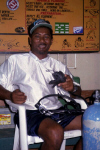 Hedo’s
equipment is renewed annually except for the tanks, which a kept certified
and inspected every few years.
All the regs, the compressor and tanks valves are expertly maintained and
repaired by Boise, who also is the supervisor of the water sports staff.
Hedo’s
equipment is renewed annually except for the tanks, which a kept certified
and inspected every few years.
All the regs, the compressor and tanks valves are expertly maintained and
repaired by Boise, who also is the supervisor of the water sports staff.
If you have a problem with your equipment, Boise will be more than happy to
attempt a repair. He is
normally successful. You might
consider giving him a discreet ‘thank you’ for this effort.
Caribbean waters have creatures that, if harassed, can harass back.
Some do not move. Most notably are the fire coral formations and certain
other corals that can sting when touched.
Coral is actually an animal with its skeleton on the outside; it the animal
inside that releases the poison that causes welts.
When in doubt, ask the divemaster if it is ok to touch something, then
do so gently. Gloves are
allowed at Hedo, but keep in mind that you are diving in a marine preserve,
so try to stay off the coral, as they are fragile, and do not pick up shells
or other objects. Please leave
them for others to see on another day.
Moving creatures include jellyfish, sea lice (actually embryonic thimble
jelly fish), sea hornets (another jellyfish).
Sea lice are seasonal: they appear late April to early May and last until
mid-June. For more info on sea
lice:
http://www.fau.edu/safe/sea-lice.html.
During October, very large jellyfish, locally called Moons, show up in
large numbers. Fortunately,
they do not sting. However,
there are reports of jellyfish that do sting present year around, and this
reason, I recommend you wear a Lycra full-body reef suit.
I also recommend you offer a respectful distance to barracuda, the spines of
the rockfish, moray eels and the mouths of the puffers and turtles.
If you get stung, go to the nurse as soon as you get ashore.
She has ointments that neutralize the agents that create the stinging
sensation. Many divers carry
meat tenderizer that can neutralize the venom, as well.
Despite the rumors, urine is not that effective in relieving the pain,
but some have a fetish called …. er, never mind.
It goes without saying that a shark encounter is exciting.
Most often, the sharks are of the nurse variety and are sleeping.
I have seen sharks on about 10 percent of my dives at Hedo. All but one was at 90 feet and all but one was sleeping.
I recommend you resist the urge to find out what the skin feels like by
trying to pet it. Awaking a
sleeping shark is not a good idea.
OK, Ah…ahumm, Can you dive nude?
Well, yes actually you can.
Some divers make it a routine.
I, personally, do not because of 1) the water-born creatures that bite back,
and 2) I have several dangling body parts that look like, well, bait and 3)
you do, occasionally, run into dive groups from the other resorts in Negril
and some do have kids as part of the dive group.
I personally think it should be the family’s decision to go nude or
encounter nude people; not forced on them.
And there was the time when a nude female diver somehow attracted a
sharksucker (Ramona) that became very curious of her…. ah …well you know.
She was completely unaware of its presence during the dive, despite our
attempts to alert her. We did
have to get close to try and fend it off.
Any more questions?
My name is Chuck, been to Hedo 30 times (more, perhaps, by now), and I have
logged over 700 dives at Hedo over the years.
I have been diving for 30+ years, and I am certified as a divemaster.
Either post your questions on the Hedo II message board, or email me.
I can be reached at
hedodivr@optonline.com.
If I do not answer right away, I am probably at Hedo, again.